How to Use Singing Bowls for Meditation
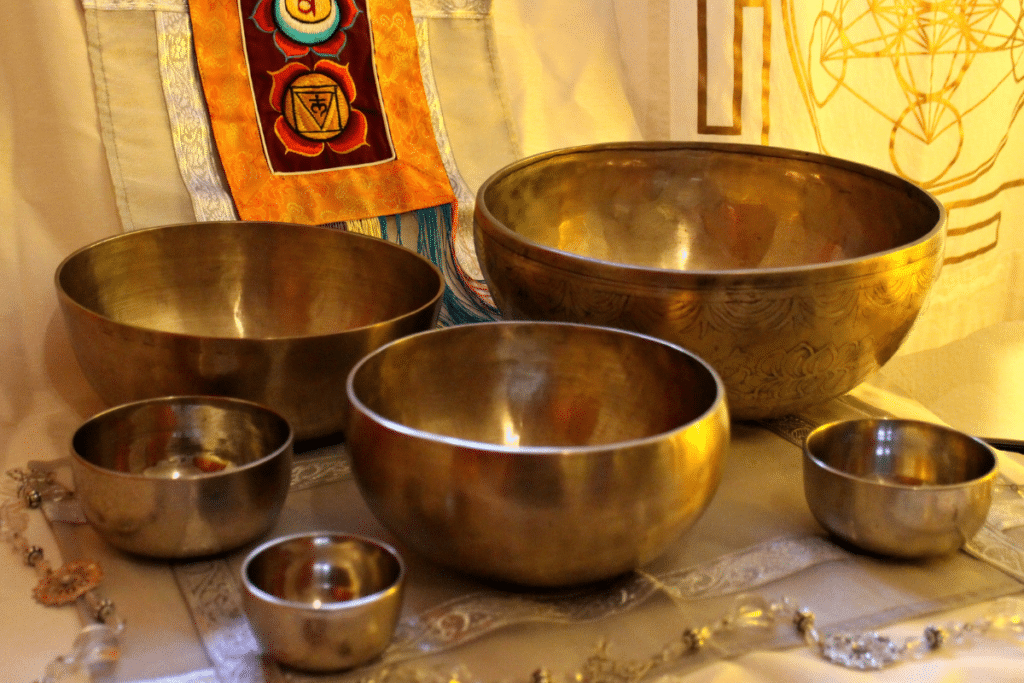
So, What is a Singing Bowl?
A singing bowl is a type of bell, called a standing bell. They are traditionally used to signal the beginning and end of a meditation or spiritual practice. The user rings the bell by striking a felt-covered mallet or stick on the outside of the bowl.
These days, we use singing bowls as instruments of healing and divine connection. They are played by running the stick around the rim to make the ‘singing’ sound, and by striking the bowl in the traditional way. The sound vibration has healing properties and induces feelings of wellbeing and peace. It is also believed that some bowls emit frequencies that align with the sacred sound of the universe, and therefore, can help us to connect with source energy.
Singing bowls come in a wide variety of sizes, from a few inches to two feet in diameter. Smaller bowls produce lighter, higher tones, while larger bowls offer deeper resonance. Singing bowls are crafted from metal alloy or crystal. Each material provides a different sound and spiritual benefit. There is a considerable increase in popularity for using crystal singing bowls for meditation, because, along with the therapeutic properties of the sound frequencies, the gemstone itself provides additional healing benefits.
The History of Singing Bowls
The exact origins of singing bowls for meditation and recreation are ancient and shrouded in mystery. They are thought to have originated in ancient Mesopotamia some 5000 years ago, though, as there are no written records, nobody knows the exact date and location of their creation. There are many speculations, however, including theories that Tibetan Buddhist monks used singing bowls 2000 years ago for sacred rituals where they gained immense spiritual powers such as astral projection.
Modern Western Usage
Whatever the real origins and history of singing bowls, they are indeed objects of spiritual power. In western culture, the popularity of singing bowls has exploded over the last 50 years. Meditation practitioners, yogis, sound healers, musicians, and therapists have all integrated singing bowls into their practices. There are now many practitioners of singing bowls meditation, using these sacred instruments to enhance wellness, emotional balance, and spiritual connection.
The physical, psychological, and emotional effects of singing bowls and sound therapy have been the subjects of many scientific studies. These studies demonstrate significant benefits of using these beautiful instruments for healing and happiness.
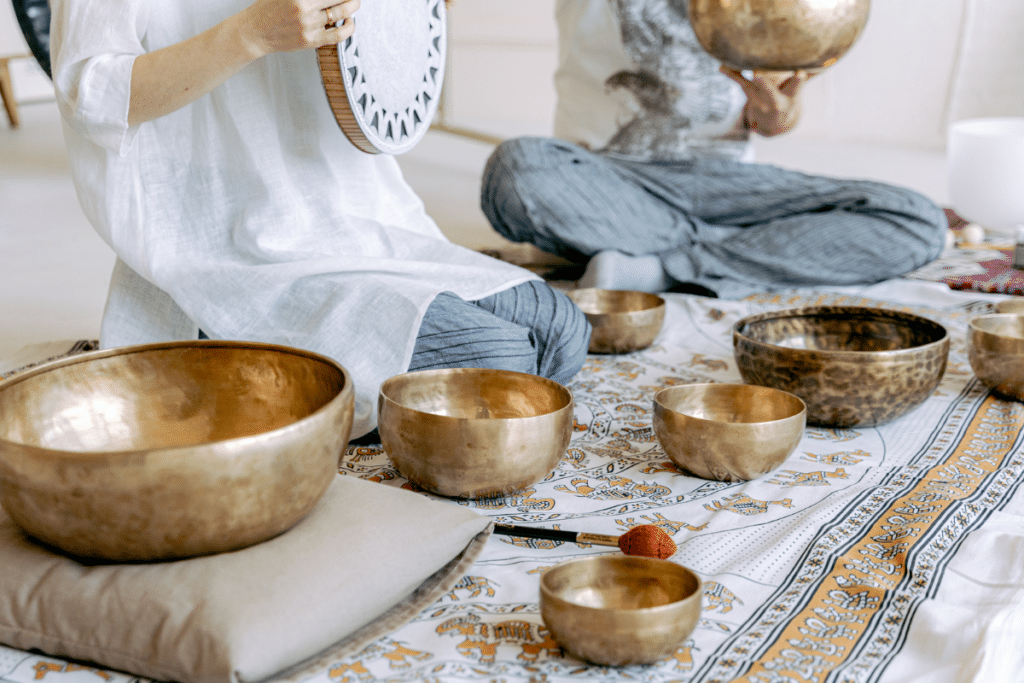
Benefits of Singing Bowls
There are so many positive effects of using singing bowls for meditation and healing, with new research emerging all the time. Here are some of the many benefits:
- Physical and emotional healing
- Focus and mental clarity
- Balancing the left and right hemispheres of the brain
- Spiritual/divine connection
- Chakra balancing and energy healing
- Relaxation and reducing tension
- Switch from sympathetic to parasympathetic nervous system
- Increasing positivity and joy
- Reducing feelings of depression, anxiety, and anger
- Alleviate the effects of cancer treatments
- Facilitating deeper meditative states
- Reducing stress and inflammation
- Reducing the perception of pain
- Lowering blood pressure
- Creating a sense of inner peace
The Science of Sound and Vibration
Quantum physics has proven that everything is energy. The universe and all the things in it (including humans) are simply energy vibrating at different speeds. The slower the vibration, the denser the object – wood, ice, our bodies, the earth, plants, etc. The faster the vibration, the less dense the object – water, gas, thoughts, emotions, light, and sound.
Our bodies respond to the energetic frequencies produced by singing bowls in a variety of ways:
1. Chakras
We have seven main chakras (energy centers), and hundreds of smaller chakras, connected by pathways called meridians. Each of these chakras resonates at a different frequency. It is believed that illness and dis-ease occur when our chakras are blocked or unbalanced and not resonating at the correct frequency. By placing singing bowls onto the chakra points, we can correct these disharmonies and bring the chakras back into balance. This realignment allows the vital life-force energy (prana in Sanskrit), to flow through the meridian system, ensuring optimal health and freedom from dis-ease. This is one of the most powerful benefits of using singing bowls for meditation.
2. Water
The human body is comprised of 50-65% water. This water serves many essential functions, including the transportation of nutrients and electrical impulses around the body. When exposed to the vibrational frequencies of singing bowls, the water synergizes with this healing energy and transmits it around the body. To see the remarkable effect of sound vibration on water, you can look up ‘Tibetan singing bowl, water inside’ on YouTube and see for yourself how active the water is when the bowl is played. Try it yourself if you have your own bowl. Once you have seen this phenomenal effect in action, it is easy to understand how powerful the impact of singing bowl vibration would be on our bodies with their high water content.
3. Brainwaves
It is a well-researched fact that when we engage in activities such as meditation, deep concentration, and sleep, our brainwaves change frequency to resonate at 4 Hertz – 8 Hertz. This frequency is known as Theta brainwaves, which typically occurs during REM sleep, creativity, and meditation. The vibrations of the singing bowls can alter our brain’s energetic frequency to resonate at the Theta state. This ability to alter brainwaves is the reason why so many people experience positive mental and emotional effects from a singing bowls meditation practice.
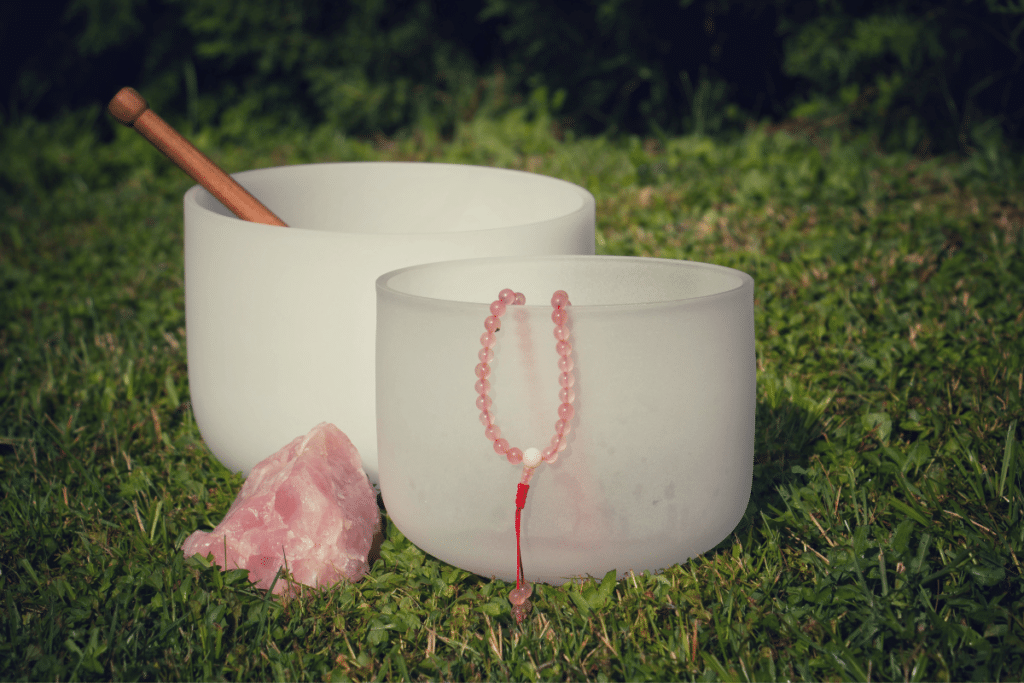
Crystal Singing Bowls for Meditation
As mentioned earlier, there are two main types of singing bowl – the traditional Tibetan bowls made of metal and bowls made of crystal, usually clear quartz. There are also crystal singing bowls available made from gemstones such as carnelian, rose quartz, amethyst, and more.
Crystals for Meditation and Healing
The benefit of using crystal singing bowls for meditation is that you receive additional healing benefits from the crystal itself. Clear quartz is a natural amplifier of energy, and so using it in any type of vibrational healing or meditation practice can multiply the energetic effects.
People throughout history have used clear quartz for purposes such as meditation, divination, healing, and ritual. While most other crystals are associated with a particular chakra, dependent on the individual gemstone’s color and energetic properties, clear quartz can balance and cleanse all of the chakras.
Clear quartz can enhance psychic abilities and intuition. It is for this reason that crystal balls made for scrying are traditionally crafted from clear quartz. This heightened intuition is beneficial for meditation where guidance and clarity are the purposes of the practice.
How to Use Singing Bowls for Meditation
Now you have a great understanding of what singing bowls are, the benefits they can provide, and the different types of singing bowls available. But how do you actually use one for meditation?
The first thing to mention is that it is not as easy as it looks to play a singing bowl correctly. It takes a little time and practice to get it right. Also, each bowl is different; it is almost like they each have their own unique personality. Even if you have owned or played one before, it might take a little time and patience to get to know your new bowl.
Playing Your Singing Bowl
Hold your hand out flat and place the bowl in the center of your palm. Keep your hand as flat as possible; a cupped hand around the base of the bowl absorbs some of the vibrations. If you have a larger bowl that won’t fit in your hand, place it on its cushion on the floor in front of you.
There are two ways to produce a sound from your bowl. To play it like a bell, strike the outside of the bowl with the stick or mallet. Explore the difference in volume and tone that you can produce depending on the strength and location of the strike. Though, don’t ever strike to bowl hard enough to damage it. You can close your eyes and enjoy the resonance of each strike.
To make the bowl sing, run the stick around the outside rim of the bowl, being careful not to use too much pressure. The sound will build with time and can reach a high volume. Once you have reached an appropriate intensity, stop circling the bowl and close your eyes. The sound will continue, and you can enjoy listening to it as a focus for your meditation practice. As you get used to playing the bowl, you may find that you can play it with your eyes closed once you get it started.
Healing the Body During Meditation
You can place the bowls on your chakra points or on other parts of your body that need healing. For example, if you feel that your personal power is not strong enough, your Manipura (solar plexus) chakra may be blocked or unbalanced. Place the bowl below your ribs and above your navel and play it from there. Or, if you have any muscular pain, place your bowl onto the affected area and allow the sound waves to wash through, cleansing and healing as they go. Some areas may require the help of a friend to ensure the bowl stays put. Remember, when you use crystal singing bowls for meditation, you receive crystal healing therapy, too.
Mindfulness Meditation
Focusing on the sound of the bowl is a form of mindfulness meditation. In mindfulness meditation, you bring your awareness fully into your experience of the present moment. You can practice mindfulness meditation in two ways. The first is by holding a general, open awareness of everything that is happening in your current experience. The second is to use a specific focus as an anchor, for example, the breath, a mantra, or a sound. Singing bowls meditation falls into this second method. Focusing on the sound of the bowl and our physical experience of the vibrations helps to calm the mind and foster a sense of wellbeing and inner peace.
Open Mind vs. Empty Mind
Many people mistakenly think that during meditation, they have to empty their mind completely. This misunderstanding tends to prevent many people from engaging in a regular meditation practice and enjoying all of the benefits that it offers. The goal is not to have an empty mind, but to have an open mind. Trying to empty your mind is a futile task and almost impossible for anyone who is not enlightened! Attempting this during meditation will result in frustration and aversion to the practice.
Instead, focus on your anchor, which in our example is the sound of the singing bowl, and each time a thought arises, acknowledge it and allow it to pass. If you realize that you have gotten lost in thought, no problem, simply bring your awareness back to the sound, back to the present moment. It is never too late in the practice to begin again. As your practice develops, you will notice that you can remain focused on the anchor for longer periods of time.
Creating a Ritual
It is helpful to create a ritual around your singing bowls meditation practice. A ritual is a series of actions that you perform each time you engage in the activity. This ceremonial attitude helps to make the practice feel sacred and special, and therefore, you treat it with more care and respect.
Elements of your ritual could include:
- Space clearing – decluttering, cleaning, smudging
- Lighting candles to create ambiance
- Using incense or essential oils to perfume the space
- Doing some simple yoga stretches to prepare your body
- Taking ten deep mindful breaths to settle your mind
- Creating an altar or shrine with inspirational objects, statues, flowers or images
- Chanting a mantra for a minute or two before you begin
- Placing specific crystals on or near you to benefit from their energies
Whatever you choose to include in your ritual, it should inspire, calm, and center you, preparing you for your mindfulness meditation practice.
In Conclusion
Singing bowls are spiritual power objects that can heal us physically, emotionally, and spiritually. They can help to promote a sense of inner peace and connection to divine source energy. We can use metal or crystal singing bowls for meditation and healing practices, and each has its own unique benefits.
It is vital to get to know your bowl and practice playing it so that you can relax more deeply when you use it for meditation. Close your eyes and connect with the sound and sensation of the vibrations, bringing your awareness back whenever you notice you have gotten lost in your thoughts. Be kind and gentle with yourself – you cannot get this wrong. Keep going, and it will start to feel easier and more natural.
Creating a sacred container around your singing bowls meditation by designing a personalized ritual will help you to prioritize your meditation time. Above all, enjoy connecting with this nourishing and healing practice, and all the benefits it can offer you.




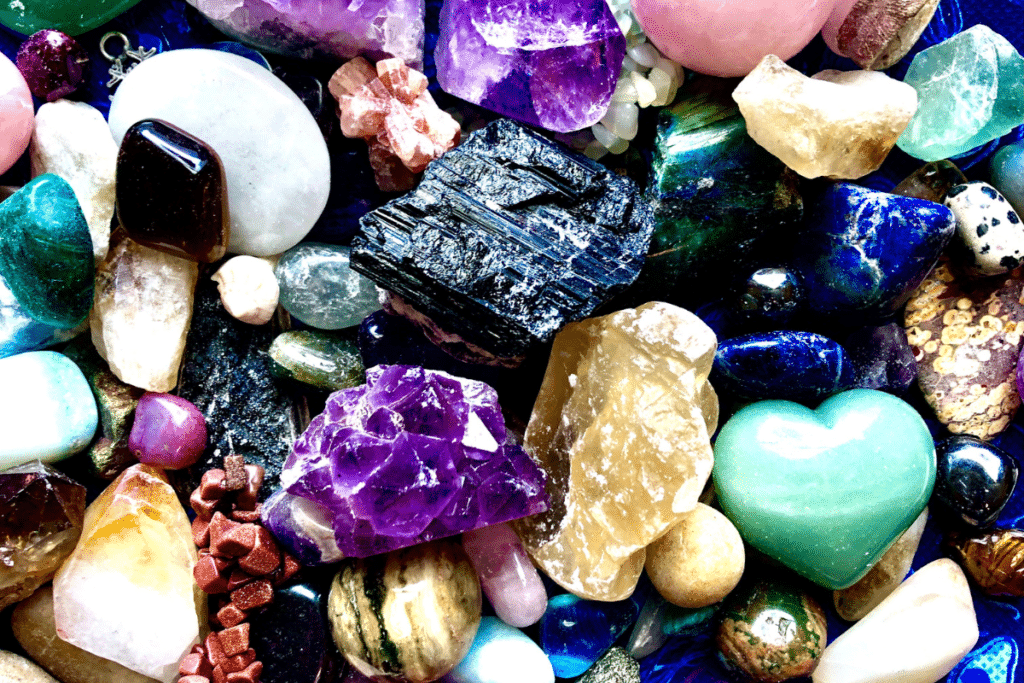

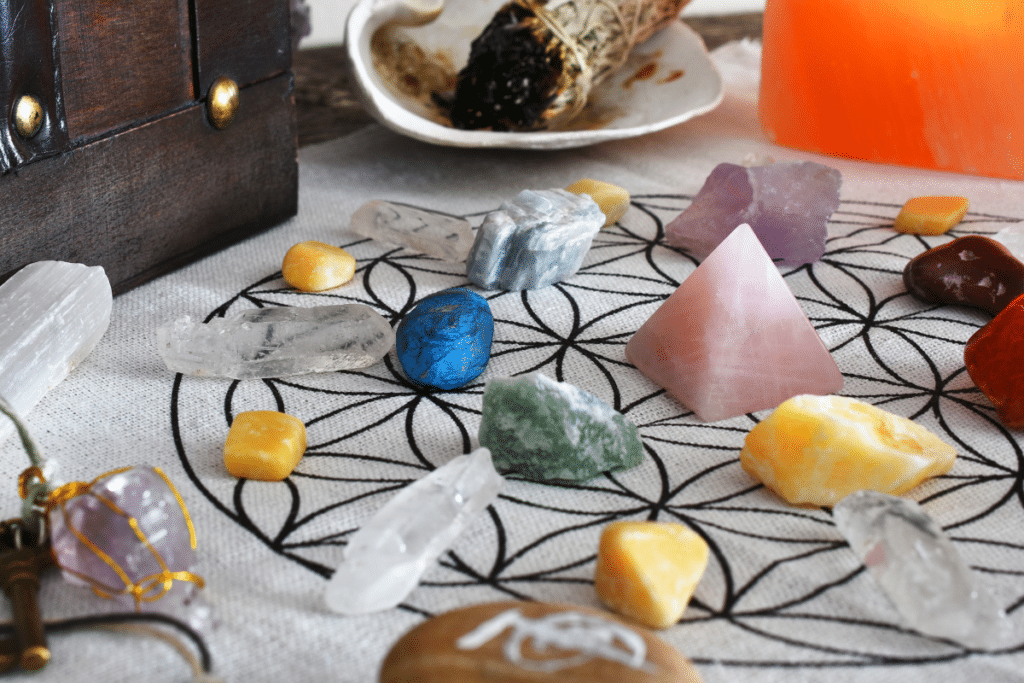
[…] Singing bowls are excellent chakra retuning tools. You can purchase one that vibrates at the same frequency as the Svadhisthana to open your sacral chakra. The best frequency for remedying an unbalanced sacral chakra is Solfeggio frequency 417 Hz, and keynote D. If you have a Svadhisthana signing bowl, play it by striking it with the mallet or stick gently around the rim. Or, you can run the stick around the outer edge of the rim to play the bowl and make it sing. Once you have built up some sound energy, sit and allow the sound waves to wash over you. You may also like to place the bowl on the sacral chakra area and play it so that the vibrations directly enter this point. If you do not have a singing bowl of your own, try listening to a Svadhisthana sound bath like this one. […]
[…] chakra you want to retune. The keynote of Vishuddha is G, and the Solfeggio frequency is 741 Hz. Singing bowls that are attuned to this frequency can provide potent healing for the throat chakra. If you own […]
[…] vibrations are excellent tools for reharmonizing chakra energy. Singing bowls that are attuned to the frequency of the chakra you wish to balance are particularly […]
[…] chakra you want to retune. The keynote of Anahata is F, and the Solfeggio frequency is 639 Hz. Singing bowls that are attuned to this frequency can provide potent healing for the heart chakra. If you own […]
[…] vibrations are excellent tools for retuning chakra energy. Singing bowls are particularly useful, especially if you use a bowl that is attuned to the frequency of the […]
[…] any ritual with a few minutes of mindful breathing or meditation to ground and center you. Singing bowls can be useful for clearing energy and getting you into the right […]
[…] popular self-care activities include meditation, yoga, personal and spiritual development, time to do nothing to rest and unwind, reading, art, […]